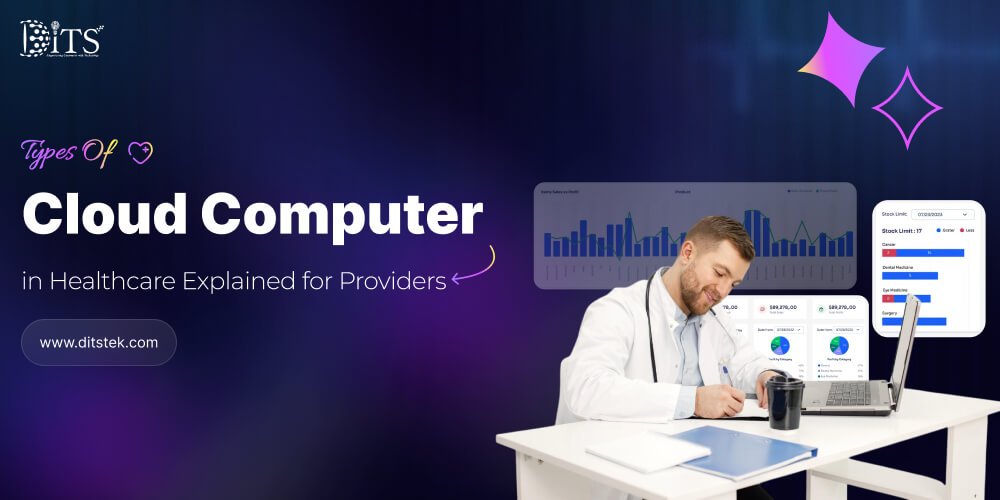Types of Cloud Computing in Healthcare Explained for Providers
Ditstek Blogs
Healthcare organizations are using cloud computing to store, share, and analyze medical data. The pandemic situation allowed the healthcare sector to build its entire technology infrastructure at the speed of light. The majority of healthcare institutions have given the green light to a shift to the cloud, as it enables secure data, lower costs, and better medical treatment through remote operations and collaboration.
The use of cloud technology in healthcare empowers a company’s IT systems to access the latest features, enhancing functionality and capabilities. This blog shares the challenges, benefits, and types of cloud computing in healthcare and how it helps organizations store, share, and organize data.
What Is Cloud Computing in Healthcare?
The term “cloud” in healthcare refers to the accessibility of data centers over the Internet, where data is distributed rather than centralized. Cloud provides a flexible model for healthcare stakeholders to access servers remotely while managing a large volume of data without geographic restrictions.
Cloud-based healthcare systems store important medical data, including electronic health records, medical images, lab results, and patient data. Cloud systems enable service providers to process large volumes of healthcare data within seconds.
Healthcare institutions often opt for cloud systems to achieve greater privacy, lower costs, enable remote operations, and facilitate collaboration in care. Employing cloud computing in healthcare has enabled innovative approaches to enhance the functionality of IT systems.
Here’s where it gets interesting. Cloud computing in healthcare isn’t limited to electronic health records anymore. It powers remote patient monitoring, supports diagnostic imaging, and supports healthcare asset management. A radiologist in Vancouver can review a scan uploaded by a clinic in Ottawa within seconds. That’s the kind of access cloud computing provides, changing how healthcare organizations deliver patient care.
Want interoperable, governable clinical data pipelines?
Standardize records, reduce errors, and accelerate analytics using Cloud Computing in Healthcare frameworks that unify EHRs, devices, and departmental systems.
Types of Cloud Computing in Healthcare
Every healthcare organization has its own needs; some prioritize tight control and security, while others look for flexibility and scalability. That’s where understanding the types of cloud computing in healthcare becomes essential. Each model offers distinct advantages depending on how a hospital, clinic, or medical startup operates.
Public Cloud
This is often the starting point for many healthcare businesses as they step into the cloud. Public cloud services are managed by third-party providers such as Microsoft Azure, Google Cloud, and AWS. They offer affordable, quick-to-deploy solutions ideal for smaller clinics or growing telehealth startups.
The biggest benefit public cloud offers is its scalability. Organizations can expand storage or processing capacity at any time without worrying about hardware. However, since data is hosted on shared infrastructure, strict security measures are required, especially when handling sensitive patient records.
Private Cloud
Private cloud is a cloud environment that’s completely yours. It's a dedicated infrastructure built solely for one organization. It’s highly customizable and provides strict control over data, applications, and compliance protocols such as PHIPA and
HIPAA
Private clouds are ideal for hospitals, large research institutions, and enterprises that manage confidential medical data. While they come with a higher setup and maintenance cost, the trade-off is superior security and operational control.
Hybrid Cloud
A hybrid approach combines both public and private environments. This allows for adaptability as to where the different types of data are stored. In effect, an organization can have sensitive patient information on a private cloud, while non-sensitive data, such as scheduling or analytics, runs on a public server.
From a cost, scale, and preference perspective, hybrid cloud environments are best suited for businesses seeking the affordability and convenience of the public cloud, while meeting the information sensitivity of the private cloud. Hybrid systems also allow organizations the flexibility to adapt as regulations change or data volumes rise in the future.
Multi-Cloud
The multi-cloud approach takes flexibility a step further. Instead of relying on a single service provider for everything, organizations use multiple cloud services for different use cases. An organization may want to run its AI analytics on Google Cloud, have secure storage on AWS, and host applications on Azure.
A multi-cloud approach addresses vendor lock-in while ensuring time to uptime in the event of user-initiated downtime from a provider. At the same time, the multi-cloud approach creates challenges for organizations in terms of integration and maintaining consistent data governance.
Each model has its own benefits and trade-offs. The best approach will depend on your organizational size, compliance requirements, and long-term digital aspirations.
Common Challenges and Solutions
Although cloud solutions offer multiple benefits, businesses face several challenges when implementing them. Though the benefits are manifest, many organizations remain reluctant, primarily due to data security, migration complexity, and compliance issues. Let us identify the common challenges organizations face and the options for tackling them.
Data Security and Compliance Concerns
The primary and most significant challenge is data security. Healthcare executives may be understandably concerned that their patients' records are stored on remote servers, potentially leading to a security breach.
Healthcare companies need to select cloud providers that comply with regulations governing healthcare data, such as HIPAA, PIPEDA, or PHIPA. Working with a service provider that protects data privacy through encryption (eg. AES) and applying role-based access while conducting security audits sufficiently safeguards data privacy.
Migration and Integration Complexity
Moving from older systems to cloud-based solutions can be overwhelming. For hospitals that have relied upon a legacy system to manage patient data, this can be specifically daunting. Legacy modernization thus becomes an important solution. When deciding to migrate to a new cloud environment, it is crucial to carefully develop a strategy that allows existing systems to be upgraded or integrated into modern cloud environments with minimal disruption.
Vendor Dependence and Limited Flexibility
One concern many providers have is vendor dependence, where all systems rely on a single vendor. Dependence removes flexibility, which can complicate scaling or switching vendors. Multi-cloud or hybrid solutions can help, as they allow organizations the ability to shift and migrate workloads.
Data Governance and Interoperability
When multiple teams or departments manage records, data can become complex and inconsistent. This means the data may not be standardized or aligned. Conflicting data can result in inaccurate reports or compliance issues. Automated governance tools and centralized dashboards both aid consistency and improve interoperability.
How Cloud Computing Solves Them
At DITS, we are familiar with these challenges. Our staff combines technical expertise with AI-powered quality assurance to ensure each transition is smooth. We also position healthcare providers with intake processes to develop an expected cloud adoption roadmap, while minimizing downtime and ensuring compliance.
Need airtight security and compliance without friction?
Deploy encryption, RBAC, audits, and disaster recovery with Cloud Computing in Healthcare architectures aligned to HIPAA, PIPEDA, PHIPA, and GDPR.
Benefits of Cloud Computing in Healthcare
Cloud technology has fundamentally changed how healthcare organizations function. What spurred as a trend has now become a requirement, not only for data storage but also for the connection between individuals and systems.
Increased Collaboration and Data Sharing
Consider how many different people interact with a single patient's file, from doctors and nurses to lab technicians and specialists. The beautiful thing about cloud technology is that it brings all those people together. Individuals who should have access to the same patient’s medical records and test results, in real time, will have access.
There is no longer a need to wait for a report to be faxed over or emailed as an attachment. Now, everyone is looking at the same information at the same time, resulting in fewer delays, fewer repeat tests, and vastly improved coordination among team members.
Increased Security and Compliance
Security remains a concern, and rightfully so. However, cloud providers, particularly in the healthcare market, take security seriously. Most provide end-to-end encryption, multifactor authentication, and continuous status and system monitoring.
Many cloud providers are already built in accordance with some of the strictest healthcare legislation, such as HIPAA and GDPR. Access permissions, anonymized patient medical records, and audit trails help secure sensitive data, so hospitals do not worry about breaches or compliance issues.
Scalability and Agility
Healthcare data is constantly changing. One week, a company may have a manageable number of records. The following week, it may be processing thousands of high-resolution MRI scans or streaming data from wearable devices. The cloud scales with the business. Need more storage or computing power? It’s there, instantly: easy, efficient, and cost-effective.
Workflow Automation and Integration
With cloud computing, tedious, repetitive tasks in healthcare can now run on autopilot. Scheduling, billing, report generation, and claims all run by cloud-based systems that talk to each other. These platforms can also integrate with EHRs, medical devices, and third-party apps. This creates smoother workflows, fewer manual errors, and more time for staff to care for patients.
Business Continuity and Disaster Recovery
When disaster strikes, whether a cyberattack, power outage, or system crash, healthcare operations experience downtime. Cloud computing safeguards data by backing it up across multiple locations. Even with one server going down, another server can scoop up the load. It is not just a safety blanket; it also provides peace of mind that patient care will not be interrupted, no matter what happens.
Driving Innovation and Advanced Analytics
Here is where it gets fun: Cloud platforms give healthcare providers access to advanced tools available for AI, machine learning, and data analytics. This gives the potential for faster medical research, earlier detection of population health trends, and predictive care models. Hospitals are shifting from responding to illness to preventing it.
These are not the only benefits of cloud computing in healthcare. The cloud technology also supports telemedicine and virtual care, improves electronic health records management, and improves cost efficiency in healthcare process for hospitals and related businesses.
How DITS Helps Healthcare Providers with Cloud Solutions
For many healthcare organizations, moving to the cloud represents a substantial change, especially in maintaining data security, compliance, and efficient workflows. At DITS, we deliver successful healthcare solutions tailored to each organization's structure and goals.
We start with understanding your environment: how your teams work, your individual challenges, and where technology would have the most effect. With that information, we will develop secure and scalable systems that are real-time, integrated, and reliable.
We also employ AI in our software development processes, which gives us confidence in code quality, improved testing efficiency, enhanced performance, and greater flexibility in every solution we develop. The benefits of using our experience and embracing automation in our development processes will allow DITS to deliver cloud systems that deploy quickly and are easy to manage.
Whether you are replacing existing infrastructure or increasing your digital services, such as telehealth, we will make your transition seamless, and compliant, and prepared for next steps.
Ultimately, DITS supports health care operations in doing what they do best, helping patients, while managing the technology that enables the organization to function.
Need a roadmap tailored to your teams?
Get an actionable Cloud Computing in Healthcare adoption plan aligning stakeholders, timelines, budgets, and KPIs to deliver outcomes and governance.
Conclusion
The healthcare industry continues to expand in the applications of cloud computing for good reason. Hospitals, clinics, and health-tech companies are continuing an evolution that solidifies the cloud as the bridge between improved care delivery and smarter operations. The cloud enables connections between departments, secures information, and enables innovation without being constrained by physical infrastructure.
At DITS, we help healthcare organizations navigate this transition with precision. Through innovative design, AI-powered development, and continuous optimization, we ensure your cloud systems not only meet today’s demands but are ready for tomorrow’s innovations like remote patient monitoring and digital patient engagement platforms.
The future of healthcare belongs to those who build it on the proper foundation, and the cloud is where that future begins.
FAQs
1. Which Type of Cloud Is Best for Healthcare Organizations in Canada?
This type depends on your organization's size, the sensitivity of your data, and your compliance requirements. Larger hospitals tend to prefer the use of a private cloud or a hybrid cloud because of the tighter security, and control of their data. Smaller practices/clinics with limited budgets, usually favor public clouds due to the lower cost.
2. How Does Cloud Computing Ensure Data Security and Compliance in Healthcare?
Those professional cloud vendors will generally be compliant with healthcare regulations (HIPAA, PIPEDA, PHIPA). Benefits include encrypting data, multi-layer authentication, and frequent audits to ensure customer protection. Thus, with the appropriate levels of control and monitoring of access to patient data, cloud protects information better than traditional in-house systems.
3. What Is the Cost for Implementing Cloud-Based Healthcare Systems?
Costs will include cloud models (public, private, hybrid), storage, and system complexity. However, healthcare organizations can expect to invest moderately upfront, with lower operational costs in the future because the vendor is responsible for maintenance and hardware upgrades.
4. Can Legacy Healthcare Systems Be Migrated to the Cloud Easily?
It is possible, but it takes careful planning. A legacy modernization initiative can effectively update legacy systems to work with a modern cloud environment while preserving data and workflows. Working with an experienced technology partner to help navigate the complexities makes it significantly easier.
5. How Can DITS Support Healthcare Providers in Cloud Adoption?
DITS provides a reliable, cost-effective solution for healthcare organizations to migrate to the cloud securely. We design and customize healthcare solutions specifically for each organization and team. When cloud adoption requires new testing and optimization with an AI solution, we ensure the initiative meets industry-compliant technology standards.

Nidhi Thakur
With more than 19 years of experience - I represent a team of professionals that specializes in the healthcare and business and workflow automation domains. The team consists of experienced full-stack developers supported by senior system analysts who have developed multiple bespoke applications for Healthcare, Business Automation, Retail, IOT, Ed-tech domains for startups and Enterprise Level clients.
Recent Posts
Get in touch









.jpg)
